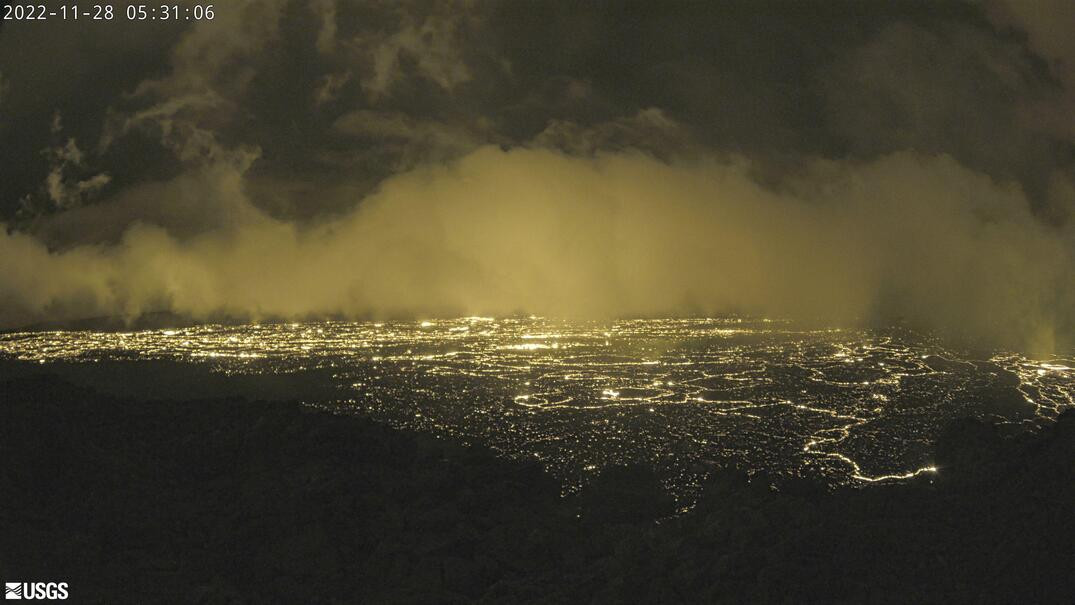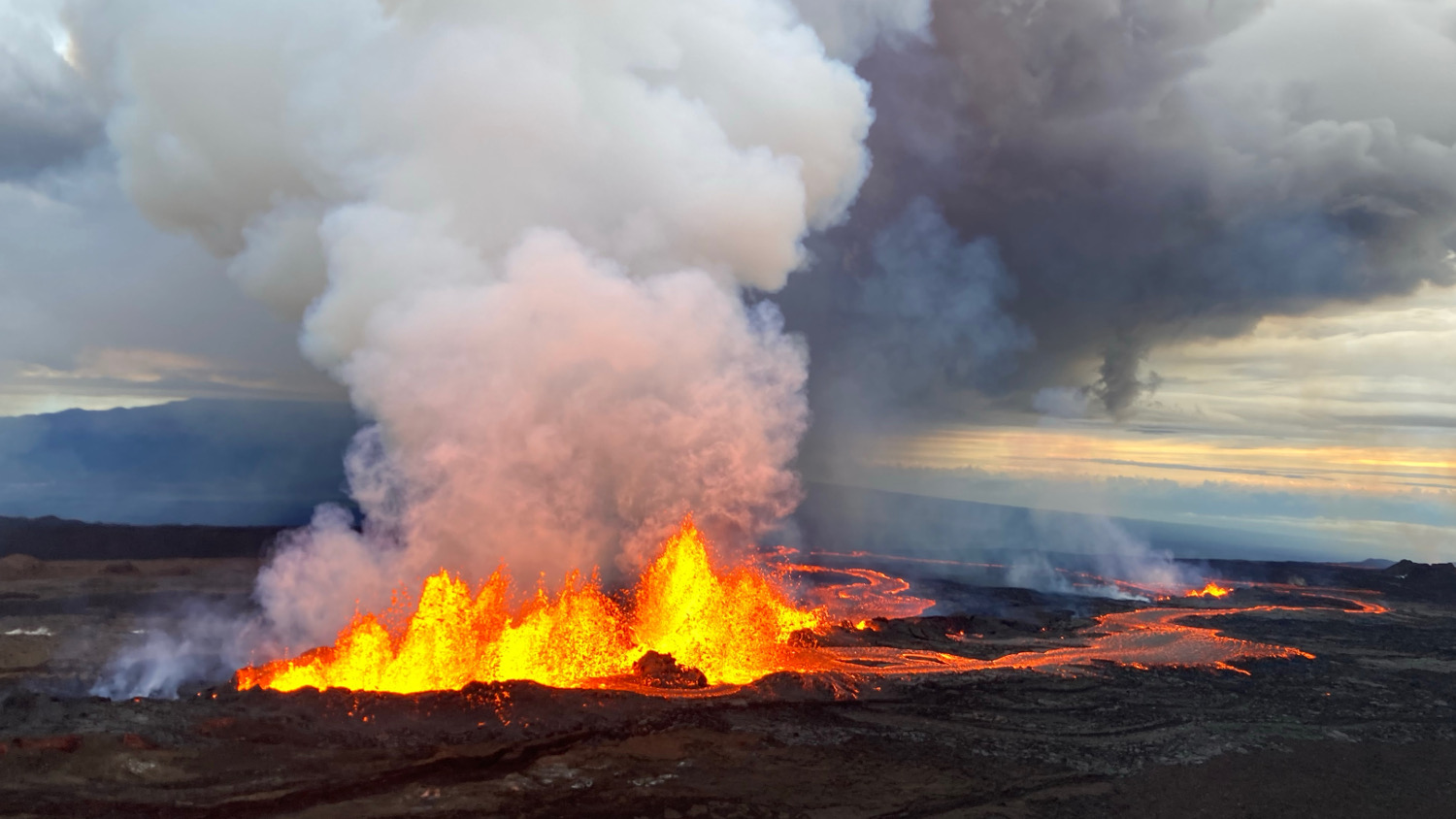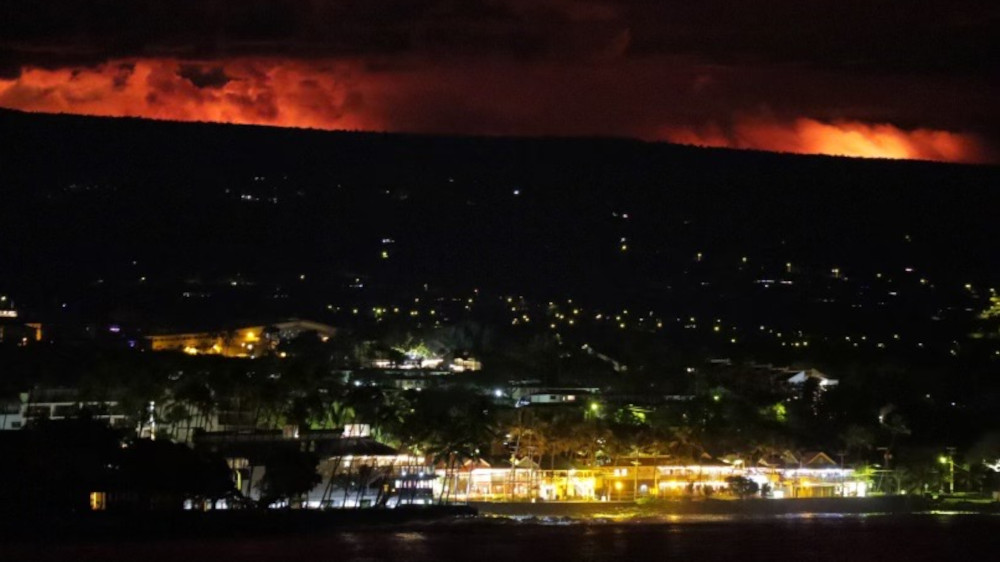(BIVN) – Mauna Loa is not erupting, and its USGS Volcano Alert Level is at NORMAL. The most recent eruption of the giant Hawaiʻi island volcano occurred in late-November of 2022, and lasted about two weeks. The start of the eruption is the topic of this week’s Volcano Watch article, written by U.S. Geological Survey Hawaiian Volcano Observatory scientists and affiliates.
From the Volcano Watch article:
In the late hours of November 27, 2022, Mauna Loa began erupting. Lava was visible on the west side of the Island of Hawaiʻi, from Kailua-Kona to Waikoloa. Social media was ablaze with pictures and commentary of lava flows descending the west flank toward communities.
This volcanic activity caused anxiety among local residents, and tensions remained high after the USGS Hawaiian Volcano Observatory (HVO) issued a statement that the flows were not a threat to communities and people living on the west side of the island. How could that be? “We see the flows!” was the public’s response.
Past eruptive behavior is an excellent guide to future activity. From past eruptions, we know that lava flows from the Southwest Rift Zone of Mauna Loa can threaten communities in a matter of hours and quickly reach the ocean.
It is the same past behavior that gave HVO the confidence to say that those flows, seen from Kona, were not a threat to folks living on the west side of the island. Let us explain.

Image from a temporary USGS research camera positioned on the north rim of Mokuʻāweoweo, showing the eruption in the summit caldera of Mauna Loa volcano on Nov. 27, 2022.
Mauna Loa has erupted 34 times since 1843. Each eruption started in Mokuʻāweoweo, and likely the south caldera area; however, there are very few eyewitness observations of the onset of eruptions in the 19th and 20th centuries due to the great distances, high altitude, cold, and lack of water (to name a few).
Trying to sleuth the activity from geologic mapping is confounded by frequent eruptive activity, as old eruptions were covered by new eruptions, obliterating the past eruptive history.
Fortunately, there were some astute observers and intrepid adventurers that hiked to the summit for the 19th and early 20th century eruptions. And in the late 20th century, technology (airplanes and satellites) helped us to document some of the activity.
Based on those observations, we can say with confidence that the activity in the early hours of the 2022 Mauna Loa eruption was similar to some past eruptions. Similar reports from the west side of the island—of flows descending from the south caldera region toward South Kona, as observed in 2022—also occurred in 1851, 1879, 1887, 1897, 1899, 1903, 1907, 1926, 1933, 1940, 1949, 1975, and 1984.
Flows that erupted in the south caldera region, but were not confirmed by visual observations from Kona, include the 1868, 1916, 1919, and 1950.
Flows that are visible high on Mauna Loa’s west flank erupt from the south caldera region of Mauna Loa, outside the topographic depressions of the summit region. Activity in this location is easily visible from south and west sides of the island, which can be alarming. However, none of these previous lava flows in the south caldera region, whether observed or not, traveled far enough to threaten South Kona. Thus, just because folks can see lava from the west side of the island, high on Mauna Loa’s west flank, does not indicate that lava will head south or that Kona will be inundated.
In 2022, monitoring parameters clearly indicated that only the summit region was active in the initial hours, without lava propagating down the Southwest Rift Zone. This is why HVO was confident in issuing a statement that the flows were not a threat to the west side of the island.

USGS: “Aerial photograph of the dominant fissure 3 erupting on the Northeast Rift Zone of Mauna Loa, taken at approximately 8 a.m. HST November 29, 2022. Fissure 3 fountains were up to 25 m (82 ft) this morning and the vent was feeding the main lava flow to the northeast.” (USGS photo by M. Patrick)
Since the south caldera region is often active at the start of eruptions, and lava flows are common, it is important to be aware that this type of activity is normal, and it does not necessarily constitute a threat to communities on the western flank of Mauna Loa. Ultimately, we must wait until Pele decides whether the eruption will move out of the summit and south caldera to determine if it poses a threat.
Eruptions are an inevitable part of Mauna Loa’s future, but the associated hazards can be anticipated by careful documenting of its past behavior as a guide to the future. Additionally, we are increasing our webcam network to include views of the south caldera and upper Southwest Rift Zone regions of Mauna Loa. In the future, we will have near real-time visual surveillance of this portion of the volcano, enhancing our existing monitoring network and aiding us in our primary mission: to issue timely and accurate warnings of hazardous volcanic activity.


by Big Island Video News6:26 am
on at
STORY SUMMARY
ISLAND OF HAWAIʻI - This week's Volcano Watch article addresses the concerns of the west-side of the island, where lava was visible when the 2022 Mauna Loa eruption began.